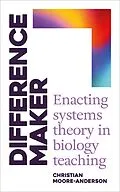Rarely have I been so convinced by the power of a new theoretical underpinning for a pedagogical technique such as the one presented here. -Helen Darlington, Faculty Progress Leader for Science at South Wirral High School
Laying down a new path in biology teaching, this book explains how to enact a learning environment where meaning isn't transmitted or discovered but co-constructed. It shows how to provoke understanding through diagrams and dialogue in lessons that emerge from continuous adaptation. It reveals how to teach-with students rather than merely teach-to them.
Inside you'll find:
- The recursive teaching model. An evidence-and-theory informed model for co-constructing meaning with students rather than just telling them or having them discover alone.
- Detailed examples of my lessons. I show the exact diagrams I've drawn in a lesson and explain how I've drawn them step by step. I show the questions I've asked students, at what point in the lesson, and why.
- A theory-informed how-to guide for planning explanations. I show how to explain biological concepts by applying the variation theory of learning and enactive cognitive science. This simple heuristic should cut your planning time while improving your students' understanding.
- A theory-informed how-to guide for encouraging conversation in lessons. You never know how students will interpret a new explanation so conversing with them is essential. Using a new model for conversation, I show how to keep everyone on the same page. Through examples from my lessons, I show the types of questions that allow a conversation to develop without becoming too open and inefficient.
- A theory-informed how-to guide for co-constructing stock and flow diagrams. These diagrams have helped my teaching become more conceptual and conversational. I show how to read, design, and teach them with detailed lesson examples. There's also an appendix of 37 diagrams I've used with my classes.
- A new model of curricular content. I show that the curriculum is not just a list of content of equal weight. There are key ideas that give meaning to the rest of the curriculum. I explain the concept of "metacontent" and show how I apply it in detailed examples.
- The first type of metacontent I explain is a set of systems principles that I share with students and discuss during every topic. These unifying principles avoid the feeling that biology is just a lot of facts to learn.
- The second type is understanding understanding itself. I share a taxonomy of understanding that allows students to grasp what I expect of them in every topic. I provide example sentences for each level of understanding, questions I've asked to test my students' understanding, and answers my students have given.
- A way of seeing and being. Rather than a training manual with activities to follow, this book provides teachers with a new conception of teaching, learning, and acting together in the classroom. It exemplifies all the ideas in practice from real lessons in real teaching contexts. This book will give you a new and viable perspective on teaching and learning.
Titel
Difference Maker: Enacting Systems Theory in Biology Teaching
Autor
EAN
9798227170033
Format
E-Book (epub)
Hersteller
Veröffentlichung
09.08.2024
Digitaler Kopierschutz
Adobe-DRM
Dateigrösse
5.04 MB
Unerwartete Verzögerung
Ups, ein Fehler ist aufgetreten. Bitte versuchen Sie es später noch einmal.
